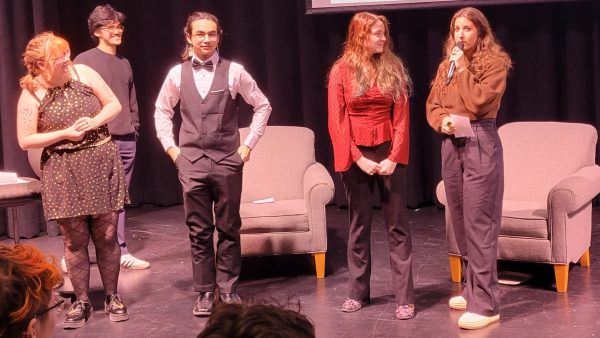Champlain’s International Women’s Day Tweets Reveal a Larger Issue
On International Women’s Day (IWD), Champlain College and the Women’s and Gender Center sent out tweets for IWD and Champlain’s Wall of Women, a wall in Fireside Lounge where students can nominate a woman who has made an impact on their life. Both posts included non-binary people, and the tweet from the Women’s and Gender Center chose to separately mention trans women.
Students immediately spoke up about their disappointment in Champlain’s choices. Replies to the tweet called out how the college invalidated nonbinary people by lumping them in with women, and trans women by singling them out in a post they are already included in.
Psychology and Secondary Education major Jayy Covert (‘22), formerly the SGA’s Director of Diversity and Engagement, quote-tweeted Champlain saying, “not all nonbinary folx are women/women-aligned and this ain’t celebrating their identities.”
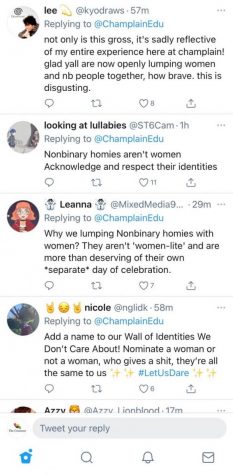
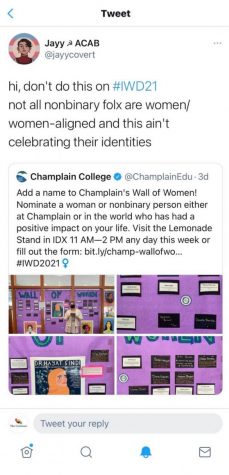
“I didn’t understand how they were able to make such an obvious mistake and think nothing was wrong in the slightest,” Covert says about their reactions to the tweets. They say they chose to respond because they are not “shy about my disdain for the problems at Champlain and I don’t have a need to hide that. Most of my work here has been calling out Champlain publicly and I don’t plan on stopping until they’ve stopped being a problem.”
Another student, Caitlin Allen, who responded to the Women’s and Gender Center’s tweet, says that “As somebody who is cisgendered, I felt it was important to point out this error to protect non-binary and trans students. I am also the communications lead for Womxn in Technology and I want those who use us as a resource to know that the leadership is in their corner and will stick up for them.”
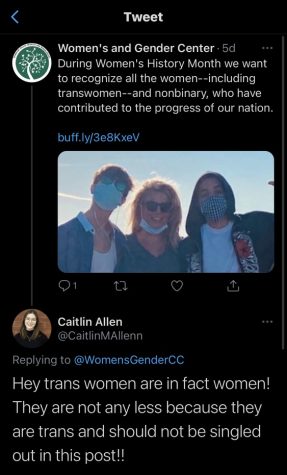
Covert and some of the other student’s replies voiced that these tweets were reflective of their experiences at Champlain. One person, “@kyodraws”, replied, “not only is this gross, it’s sadly reflective of my entire experience here at champlain! glad yall are now openly lumping women and nb people together, how brave. this is disgusting.”
Covert said that these tweets expose “The fact that despite all of the push for “DEI” [diversity, equity, and inclusion], at the end of the day, Champlain is still a homophobic, transphobic, racist, sexist institution of hierarchy. It refuses to acknowledge this fact openly and even the instances where I’ve tried to advocate for this clear and plain acknowledgment, it gets hidden in vague and coded language instead.
“I’ve only felt supported by a very few individual people, mostly other trans students. The college does not take into account trans students existing in their design of anything, including, academics, policies/procedures, physical spaces, or hiring of faculty/staff,” Covert told The Burly Beaver.
Covert also mentions other issues Champlain has ignored that negatively affected trans students, such as: when the federal government tried to take away trans students’ protections, when trans people feel disrespected by staff and faculty members, and when students wanted to debate whether trans and nonbinary people’s existence is okay.
Allen also brings up the “There are only two genders, change my mind” event held by the Champlain Republican Club in 2019 and says, “While I understand that the school did not want to infringe on their freedom of speech, I still do not understand how this event was even allowed since it actively attacked non-binary students on this campus and from what I heard, was not constructive. Just because you have the freedom of speech does not mean you should be using it to attack people for their identity.”
Champlain and the Women’s and Gender Center deleted their tweets and issued apologies on Twitter. Both apologies acknowledged how the inclusion of nonbinary people and the phrasing of “any women–including transwomen” was hurtful. Champlain continued to say that it “intentionally includes transwomen and nonbinary people in spaces and conversations that can often be exclusive and built on the binary.” The school’s Twitter then referenced two articles that they thought supported the choices made for the event.
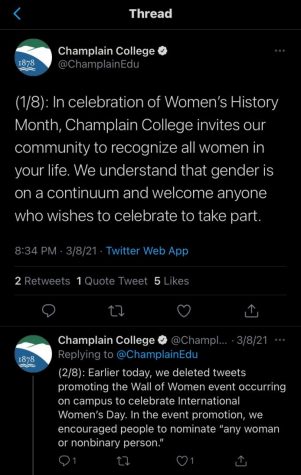

The articles were, “I’m No Longer A Women, But I Want To Be Part of Women’s History Month. Here’s Why.” by Desdemona Dallas and “Being A Trans Woman During Women’s History Month.” by Mari Brighe. Both articles captured important experiences from a nonbinary person and a trans woman, but replies to the apology indicated that they don’t justify Champlain’s use of language.
One Twitter user, “@theoreticalmoss”, posted, “While I’m glad some research was done and you admit the faults made, I would ask for consideration of all possibilities. From the sources provided, it seems that feminine nonbinary people were considered but at the detriment of considering masculine nonbinary people and the like. In the future, it may be wise to consider nonbinary people as a large subgroup of trans people and to recognize them on days like trans visibility day. We have our own days for recognition that you should partake in that you should make use of instead of a day for women.”
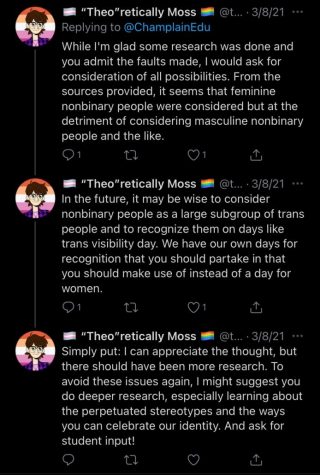
Another Twitter user “@azzy_lionblood”, wrote that the sources “Don’t advocate for what you think they are. In fact, they’re advocating for the exact opposite.” They went on to explain their reasoning by analyzing and quoting both articles and saying, “Neither of these sources read to me that the word “women” is wrong or doesn’t apply to non-cis women. In fact, the first article explicitly talks about celebrating women as someone who is not a woman. The second is about including trans and queer women.

“Invite men to your Women’s Day celebration. Invite women, all women. Invite nonbinary folks. Invite everyone. Let the guests decide if the celebration is about them or not. Deciding for them by explicitly saying is not only othering, but puts pressure on those who do show,” “@azzy_lionblood” continued.
The Women’s and Gender Center took a different approach and listed ways that it plans to create more welcoming places. The thread mentioned seeking input from the LGBTQIA+ community, forming closer relationships to create a sense of community on campus, and promoting a more inclusive environment by providing pronoun pins, and encouraging the sharing of pronouns at campus events. Lastly, they said they would “continue WGC staff education on social justice and the LGBTQIA+ community with a focus on inclusion, the consequences of identity erasure, and appropriate language use.”
Covert, who was a former staff member of the Women’s and Gender Center, says, “I know that the WGC [Women’s and Gender Center] is better than this and that this doesn’t align with their mission. I also know that the current student staff members don’t agree with what was posted and I trust that the work they want to do is in line with what I helped create as a trans-inclusive space on campus before I left my position.” The Women’s and Gender Center was asked to comment but did not respond.
For Champlain to support students who are a part of the LGBTQIA+ community Covert says the school needs to “Listen. To. Us.” They continue, “Give trans and nonbinary students actual positions to effect change and actually do the work with them. Hire staff members who we’ve vetted instead of giving us mediocre candidates to give feedback on that doesn’t actually influence any decisions. Admit that they don’t and can’t understand our experiences and instead let our experiences be the guide before any of their ideas ever even see the light of day.
“Respecting people’s identities isn’t a choice anyone else gets to decide, it’s not your identity and it’s not your life so listen to the people it’s affecting. Words historically have power, there’s so much history about words being used against the trans community to deny us our humanity, and yet we still exist and survive.”




